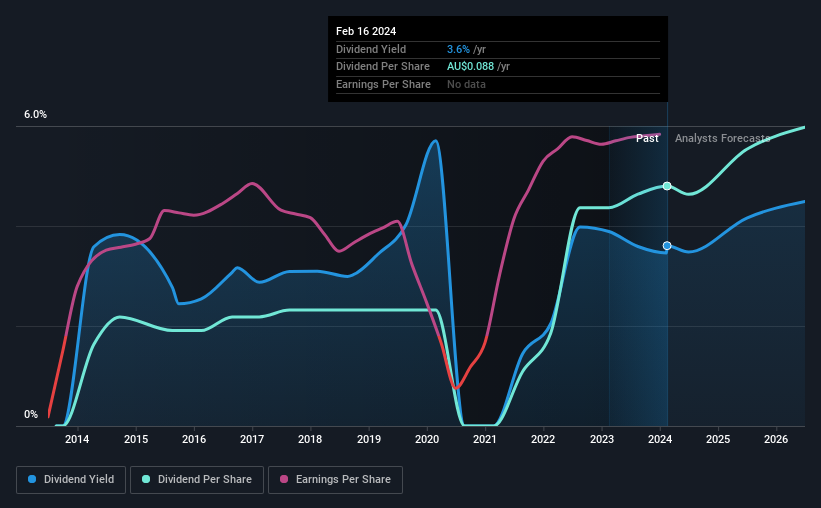Ridley (ASX:RIC) Is Increasing Its Dividend To A$0.044
The board of Ridley Corporation Limited (ASX:RIC) has announced that it will be paying its dividend of A$0.044 on the 24th of April, an increased payment from last year's comparable dividend. Based on this payment, the dividend yield for the company will be 3.6%, which is fairly typical for the industry.
View our latest analysis for Ridley
Ridley's Dividend Is Well Covered By Earnings
While it is always good to see a solid dividend yield, we should also consider whether the payment is feasible. The last payment was quite easily covered by earnings, but it made up 106% of cash flows. This signals that the company is more focused on returning cash flow to shareholders, but it could mean that the dividend is exposed to cuts in the future.
Over the next year, EPS is forecast to expand by 36.6%. If the dividend continues on this path, the payout ratio could be 52% by next year, which we think can be pretty sustainable going forward.
Dividend Volatility
Although the company has a long dividend history, it has been cut at least once in the last 10 years. The dividend has gone from an annual total of A$0.03 in 2014 to the most recent total annual payment of A$0.088. This means that it has been growing its distributions at 11% per annum over that time. Ridley has grown distributions at a rapid rate despite cutting the dividend at least once in the past. Companies that cut once often cut again, so we would be cautious about buying this stock solely for the dividend income.
The Dividend Looks Likely To Grow
With a relatively unstable dividend, it's even more important to see if earnings per share is growing. Ridley has seen EPS rising for the last five years, at 15% per annum. While on an earnings basis, this company looks appealing as an income stock, the cash payout ratio still makes us cautious.
In Summary
In summary, while it's always good to see the dividend being raised, we don't think Ridley's payments are rock solid. While the low payout ratio is a redeeming feature, this is offset by the minimal cash to cover the payments. We don't think Ridley is a great stock to add to your portfolio if income is your focus.
Companies possessing a stable dividend policy will likely enjoy greater investor interest than those suffering from a more inconsistent approach. Meanwhile, despite the importance of dividend payments, they are not the only factors our readers should know when assessing a company. For instance, we've picked out 1 warning sign for Ridley that investors should take into consideration. Looking for more high-yielding dividend ideas? Try our collection of strong dividend payers.
Have feedback on this article? Concerned about the content? Get in touch with us directly. Alternatively, email editorial-team (at) simplywallst.com.
This article by Simply Wall St is general in nature. We provide commentary based on historical data and analyst forecasts only using an unbiased methodology and our articles are not intended to be financial advice. It does not constitute a recommendation to buy or sell any stock, and does not take account of your objectives, or your financial situation. We aim to bring you long-term focused analysis driven by fundamental data. Note that our analysis may not factor in the latest price-sensitive company announcements or qualitative material. Simply Wall St has no position in any stocks mentioned.

 Yahoo Finance
Yahoo Finance 
